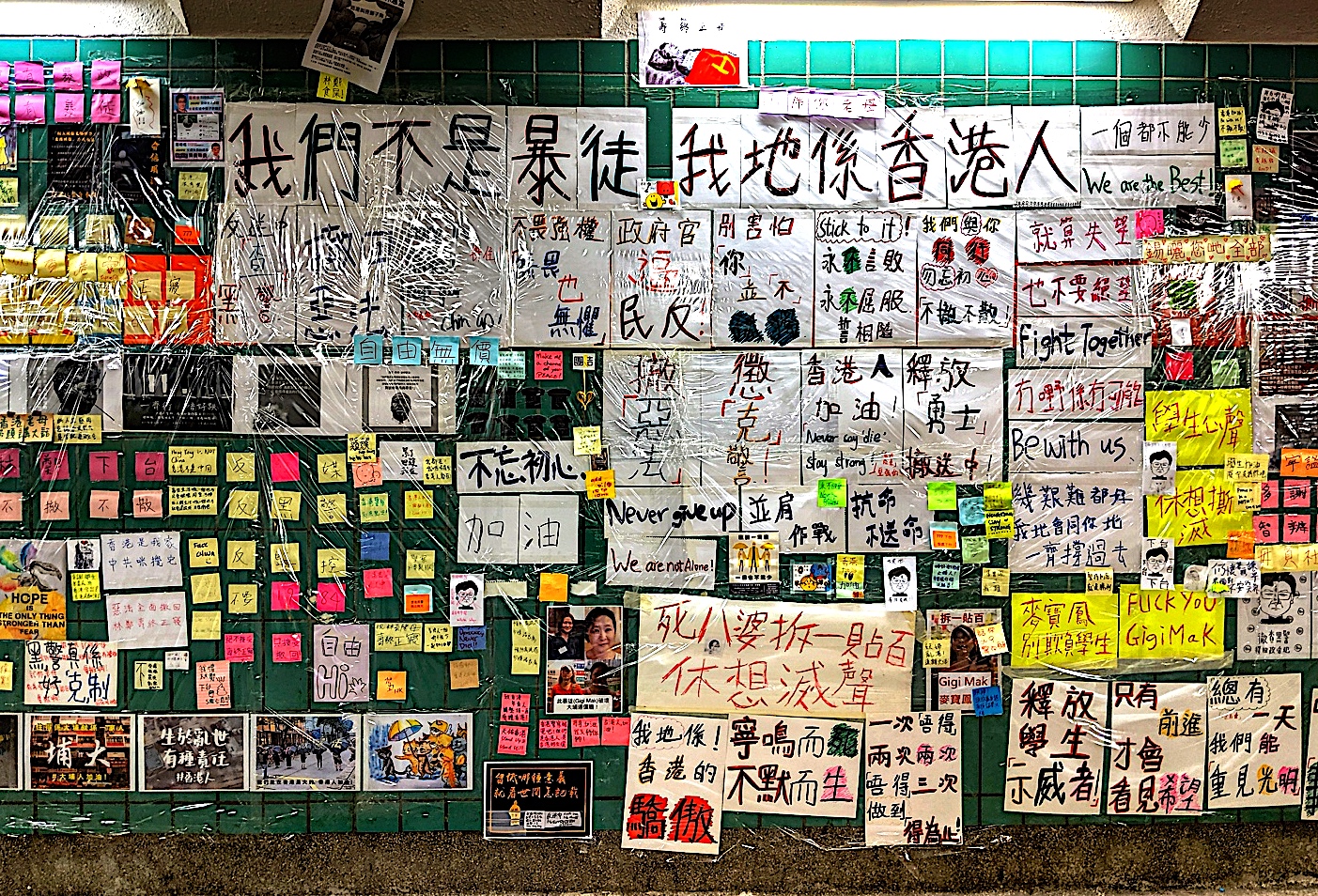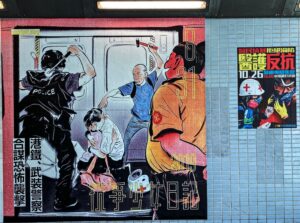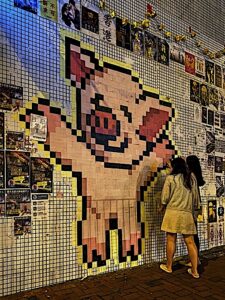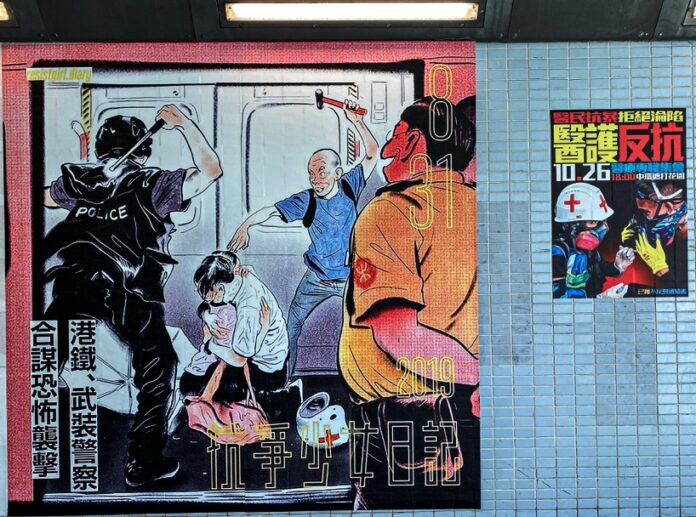Demonstrators use video talks, art, memes and songs to keep the movement alive in the virtual world
It’s been over a year since an estimated 1 million Hong Kongers marched against a controversial legal proposal that sparked the largest demonstrations in the city’s history. The bill, proposed in February 2019 by Hong Kong’s head of government, Chief Executive Carrie Lam, sought extradition of Hong Kong’s criminal suspects to mainland China for investigation and trial. This exacerbated fears among Hong Kong’s citizens that China was trying to strengthen its grasp on them after it promised, in 1997 when the former British colony was returned to China, that Hong Kong would retain a high degree of autonomy.
The proposal triggered enormous street protests in usually placid Hong Kong, with hundreds of thousands of residents, most of them university students and other young people, demonstrating against the government and police. Even after the bill was withdrawn, the protests continued through the fall of 2019; the situation had awakened collective national resentment regarding Chinese rule, attracting worldwide attention as unarmed residents stood up to the enormous military and political power of China.
While COVID-19 has forced protesters to change their tactics, the movement has persisted.
Can social media protect democracy?
The Hong Kong protests initially relied heavily on face-to-face demonstrations, which journalist Malcolm Gladwell asserted in his famous New Yorker article Small Change is the only way real social change happens. Gladwell argued that while social media platforms that encourage low-risk “weak ties” among people who often don’t know each other are useful for quickly sharing information, effective political revolution demands high risk, on-the-ground actions (“strong ties”) where people put their lives on the line. Illustrating that organizing for change isn’t necessarily an “either/or” situation, Hong Kongers have used social media, such as Facebook, Telegram groups, and LIHKG (considered Hong Kong’s Reddit) to organize protests, but have also developed strong ties to their cause, with an estimated one in four Hong Kongers participating in high-risk street demonstrations.
In a October 13, 2019 interview with 60 Minutes, a masked protester noted that Hong Kongers can face up to 10 years in prison on rioting charges for demonstrating, and that protesting could cost them their lives. Since June 2019, media outlets around the world have broadcast numerous examples of Hong Kong police using excessive force against mostly nonviolent protesters. A March 10, 2020 article in the Hong Kong-based South China Morning Post reports that Hong Kong police fired more than 16,000 rounds of tear gas, 10,000 rubber bullets, 2,000 beanbag rounds, and 19 live bullets at unarmed protesters.
Protest in the age of COVID
COVID-related restrictions on social gatherings initially stopped the massive street demonstrations. But the protesters have kept the movement alive on the Internet, via video talks, artwork, memes and protest songs. Smaller public actions, such as singalongs and graffiti street art, have been broadcast via YouTube and on other social media venues, to keep the issue of Hong Kong’s political sovereignty in the public’s mind. A popular form of protest has been the creation of “Lennon Walls” on public walls (inspired by the protest activism of John Lennon), with Post-It notes and banners proclaiming pro-democracy messages.

Protesters have also erected murals depicting ironic, unflattering caricatures of Chinese politicians, and heroic images of demonstrators. One of the most popular posts on the Hong Kong Reddit page in spring 2020 was a mural of Xi Jinpeng, general secretary of the Chinese Communist Party, portrayed as the personification of the coronavirus. Another popular image depicted enthusiastic groups of demonstrators.



Details from “Lennon Wall” protest art in Hong Kong. Courtesy of Incendo Studios.
In other digital forms of protest, Hong Kong youth have made creative use of Nintendo’s 2020 video simulation game “Animal Crossing: New Horizons,” in which players have developed and customized their own “islands” to create pro-movement art and host digital protests. They have also demonstrated in the games Grand Theft Auto Online and Pokémon Go to organize and promote sites where rallies would be held. In reaction, China removed these games from its stores.
But even peaceful protests have been met with police and government violence, Chinese University of Hong Kong student S. Lam said in a May 2020 interview.
“Singalongs in Shatin [a Hong Kong suburb], even with the law-abiding distance between citizens, were met with police storming into the malls and pepper spraying citizens and journalists alike,” Lam said in an interview over Reddit messenger.
Lam is one of the 441,000 members of r/HongKong, a Reddit page that has existed since 2009 and has been heavily used to spread the movement’s message, and to expose instances of police brutality against protesters. Top posts on the page have included images of demonstrations, police brutality, anti-government and pro-movement street art, and memes criticizing Carrie Lam and the Hong Kong government.
Social media and other digital tools have been crucial for protesters: Ideas for demonstrations have been posted by residents on the online forum LIHKG, where proposed plans pick up steam. Protesters also heavily used the app HKmap.live to mark locations of police and road blocks, until Apple pulled it from its stores in October 2019, after receiving criticism from mainland China.
Many in Hong Kong feel that Chief Executive Lam used social distancing laws to attempt to end public protests, when she banned gatherings of more than four people standing within 1.5 meters of each other in late March 2020.
“In those large protests last year, police would give out consents; but now they use the name of “combating the virus” to ban all protests, even as Hong Kong has not seen any new infected cases,” student S. Lam said.
“Now they use the name of “combating the virus” to ban all protests, even as Hong Kong has not seen any new infected cases.” — student protestor S. Lam.
Carrie Lam, who is widely disliked in Hong Kong for her adherence to the dictates of mainland China, rolled out a series of unpopular COVID measures, including converting a public housing block into a quarantine facility, and only partially limiting travel from mainland China, something Hong Kongers felt left them vulnerable to the virus. In response, some protesters threw petrol bombs at the housing complex, and led a small bombing campaign targeting another government building and a public toilet.
Supporting the “yellow economy”
Given quarantine rules, protesters adopted alternative methods to show their opposition to Chinese control.
“Protesters [are]… promoting the “yellow economy” (shops, restaurants, and companies that support the movement; yellow was the color of the umbrellas once used to defend demonstrators against tear gas), encouraging people to register as voters to win more seats in the Legislative Council, or distributing hygienic products to those in need,” S. Lam explained.
And while street protests dropped significantly during the quarantine, the pandemic broadened feelings of discontent and anger toward Carrie Lam. Some 8,000 Hong Kong medical workers went on strike in February 2020, demanding that Hong Kong shut its borders to mainland China, to better protect Hong Kong.
Hospital Authorities Employees Alliance Chairwoman Winnie Yu told Reuters that labor unions are “a new battlefront for our protest.”
Many things are uncertain in the face of the ongoing coronavirus pandemic, including the future of Hong Kong’s pro-democracy movement.
But S. Lam says protesters remain committed to their cause: “As the government, Chinese and Hong Kong alike, show their incompetence in combating the virus, the momentum has swung more and more to the protesters’ side,” he contended.
Despite restrictions on social gatherings, Hong Kong protesters have begun returning to the streets, violating government orders and again meeting with violent responses from police.
On May 10, some 230 protesters were arrested by a group of 100 riot police in the popular shopping area of Mong Kok. According to the Hong Kong Free Press, police fired pepper spray, hitting several demonstrators and journalists. Roy Kwong, a pro-democracy lawmaker, was hospitalized during the incident, after officers pinned him to the ground by kneeling on his neck.
Ignoring outrage and opposition from protesters, China’s National People’s Congress voted resoundingly on May 28, 2020 to approve legislation that will allow the Chinese government to bypass Hong Kong’s legislature on matters of national security. Mainland Chinese leaders argued that the law was necessary to prohibit “subversion of state power, terrorism activities, secession, and foreign interference.” But Hong Kongers see this as another step toward eliminating their political autonomy.
The actions of the Chinese government and Hong Kong police have prompted criticism from political leaders around the world. In a mission to the United Nations, the United States accused China of exploiting the COVID-19 pandemic to distract the world from its tightening grasp on Hong Kong. U.S. Secretary of State Mike Pompeo said he believes Hong Kong has already lost its autonomy from China.
S. Lam applauded the U.S.’s critical stance.
“We consider the U.S. and other Western countries downgrading Hong Kong’s democracy status as a good thing, because [lack of support] would only result in the slow but sure collapse of Beijing’s regime.” — student protestor S. Lam
“We consider the U.S. and other Western countries downgrading Hong Kong’s democracy status as a good thing, because [lack of support] would only result in the slow but sure collapse of Beijing’s regime, for Hong Kong is an irreplaceable place for China to earn foreign currencies and attract international investors …. If Hong Kong is to be sacrificed, bring down the authoritarian regime with us,” he said.
He argued: “More and more people are willing to join ‘international frontlines’ – sharing truth and fighting against Chinese propaganda, on platforms like Reddit, Twitter, Facebook and Instagram – in the light of international support.”

